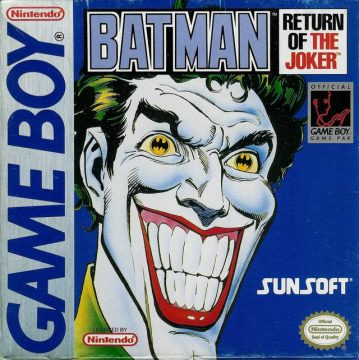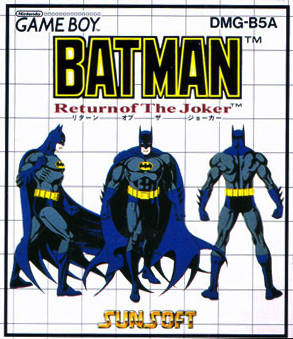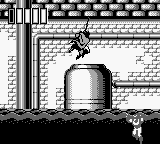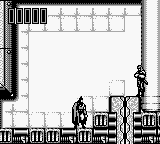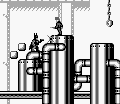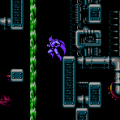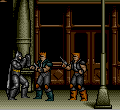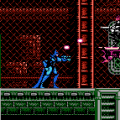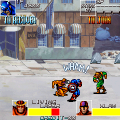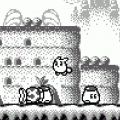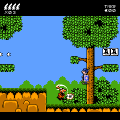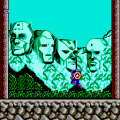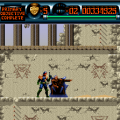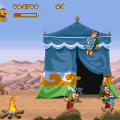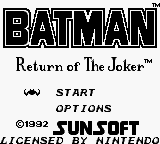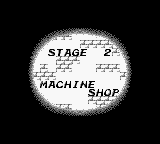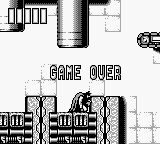- Batman: The Video Game (NES)
- Batman: The Video Game (Game Boy)
- Batman: The Video Game (Genesis)
- Batman (PC Engine)
- Batman: Return / Revenge of the Joker
- Batman: Return of the Joker (Game Boy)
Batman: Return of The Joker was obviously quickly thrown together to cash in on Sunsoft’s very successful Batman: The Video Game. As it’s not based on any particular movie or comic, the depiction of Batman is slightly closer to his look in the comics than either Sunsoft’s Game Boy and NES efforts.
Batman can punch, throw batarangs, jump off walls, and even use his grappling hook to swing over enemies or obtain hard to reach items. This is a pretty short game, so instead of going for the steady, yet low challenge increase in difficulty seen in other Game Boy games like SunSoft’s first Batman outing, all of the game’s four levels are equally challenging.
The most interesting part of this game are its bosses. While you of course fight the Joker at the end, there’s a bit of a pattern to the rest. Suddenly the wall jumping and grappling hook make sense. Batman: Return of the Joker must have begun life as a ninja action game. Maybe it began development just before the massive popularity of Sunsoft’s games based on the 1989 Batman film kicked in. The first boss is a masked hunchback with claws, who is brilliantly named Dark Claw (no relation to the Amalgam Comics character). At the end of level two, Batman is pitted against an armored samurai named Shogun Warrior. The boss of the third level is the coolest, though: a psychotic baseball player named Foul Ball. He attacks by sliding at Batman, spinning around with his bat extended, and hitting an endless supply of baseballs at him.
Batman’s sprite is a bit on the heavy side, and at a glance one would think it was based on the character’s look in Frank Miller’s comic The Dark Knight Returns. On closer inspection though, the sprite’s lower body and leg animations are shared with both the Shogun Warrior boss and running ninja enemies (albeit shaded differently). This creates some inconsistency, as the sprite looks great while standing or jumping, but is oddly choppy while running – so it seems like even Batman was a ninja protagonist during the game’s initial design. While this weakly implemented Batman sprite is the game’s only real graphical failing, it’s of course one you’ll be forced to notice from the beginning of the game to the end. With the obvious work they put into some of its frames to make it look more like Batman, it’s surprising they didn’t go all the way. The game’s entire aesthetic follows suit, with the regular enemies all having the type of designs you’d see in games like Ninja Warriors, Ninja Gaiden or Ninja Spirit.
The levels are a departure also, with none of the urban dystopia you’d expect from a Batman game. Instead you travel through a sewer, a military compound (populated entirely by ninja, don’t worry), there’s a train level, and finally a limestone cavern where you find the Joker. Each level has some impressive element. Right from the get go, you need to make constant use of your wall jumping and grappling hook to avoid drowning, as the water level fluctuates for most of the first stage. A cool sine wave style effect is used on the water here that’s impressive for a Game Boy game.
The compound is the blandest level, but does have a section where you have to take down a tank. The train level, however, is a pure graphical showcase for the Game Boy, with couple of cool visual tricks. The train itself “bumps” up and down constantly, and like in First Samurai, you can fight on top of or through each car as you see fit. There are two layers of backgrounds that scroll at different speeds, too. The backmost layer is a typical cityscape that moves somewhat slowly, while the second one is a thin strip of railing just above the train itself. This small layer scrolls very quickly, and combined with the other effects the entire level comes together in a great way. It has a sense of speed with many parallax layers, even though in reality there are only two. Level four is a cave right out of Ninja Spirit but opens up with a bang: As soon as the level starts, a huge guy with a bazooka blows a massive hole into the level architecture, which you need to quickly navigate across to survive. It’s pretty impressive to see these action movie style visuals attempted on an original Game Boy title.
The music is an interesting departure, too. Rather than SunSoft’s regular composers, the soundtrack was done by Manami Matsumae, who has a short but outstanding list of game soundtracks under her belt. Besides composing music for the original Mega Man, she’s responsible for the music in other Capcom classics like Magic Sword and U.N. Squadron. More recently she has contributed tracks to Shovel Knight, Mega Man 10 and Mighty No. 9. Her soundtrack for Return of the Joker is great, very reminiscent of her contributions to Mega Man 10 and Shovel Knight. Mega Man 2 fans will especially appreciate the song used for the game’s level select screen. The theme song used for the final fight against the Joker deserves mention, too. The fight opens up with a completely black screen, with only Batman’s face and cape visible. Then suddenly a spotlight appears on the Joker, who does a dance routine to the music before the fight begins.
Batman: Return of the Joker has no passwords or save slots, but the game is only about half an hour long. It also has a consistent but not high difficulty, making it ideal to run through while commuting. SunSoft got the most out of that Game Boy cartridge too, with every level having a totally different look and sound. It’s great that they were able to take what was obviously some disparate assets and still make a coherent and fast (for the Game Boy) game out of it. It’s worth a quick play through for the cool levels and music.

